engine overheat Oldsmobile Cutlass 1998 s User Guide
[x] Cancel search | Manufacturer: OLDSMOBILE, Model Year: 1998, Model line: Cutlass, Model: Oldsmobile Cutlass 1998Pages: 348, PDF Size: 17.46 MB
Page 219 of 348
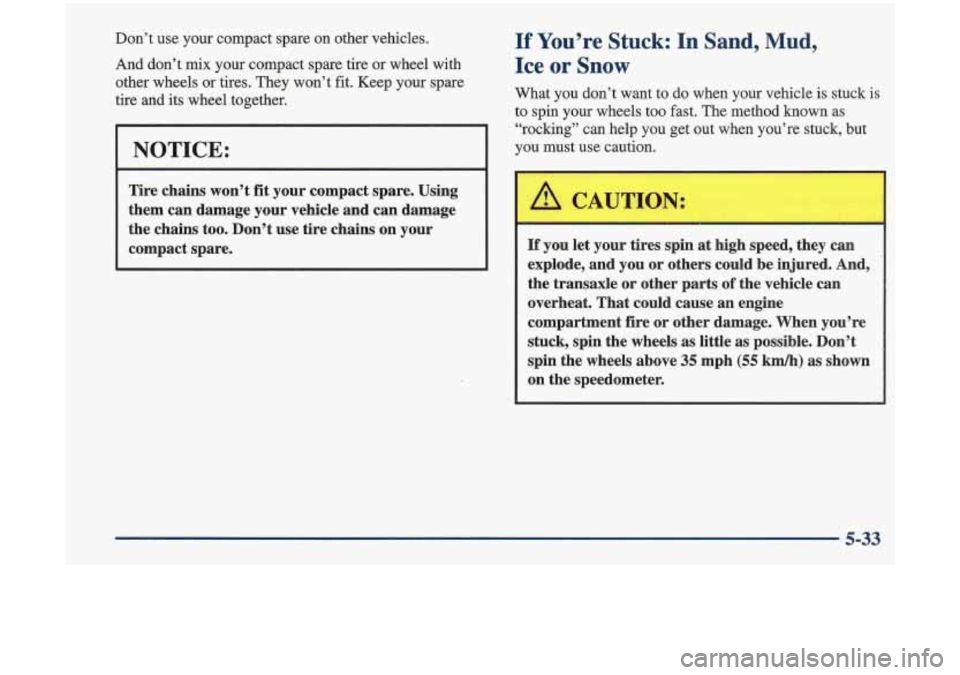
Don’t use your compact spare on other vehicles.
And don’t mix your compact spare tire or wheel with
other wheels or tires. They won’t fit. Keep your spare
tire
and its wheel together.
NOTICE:
Tire chains won’t fit your compact spare. Using
them can damage your vehicle and can damage
the chains too. Don’t use tire chains on your
compact spare.
If You’re Stuck: ,In Sand, Mud,
Ice or Snow
What you don’t want to do when your vehicle is stuck is
to spin your wheels too fast. The method known as
“rocking” can help you get out when you’re stuck, but \
you must use caution.
A CAUTION:
If you let your tires spin at high speed, they can
explode, and you or others could be injured. And,
the transaxle or other parts
of the vehicle can
overheat. That could cause an engine
compartment fire or other damage. When you’re
stuck, spin the wheels as little
as possible. Don’t
spin the wheels above
35 mph (55 km/h) as shown
on the speedometer.
5-33
Page 238 of 348
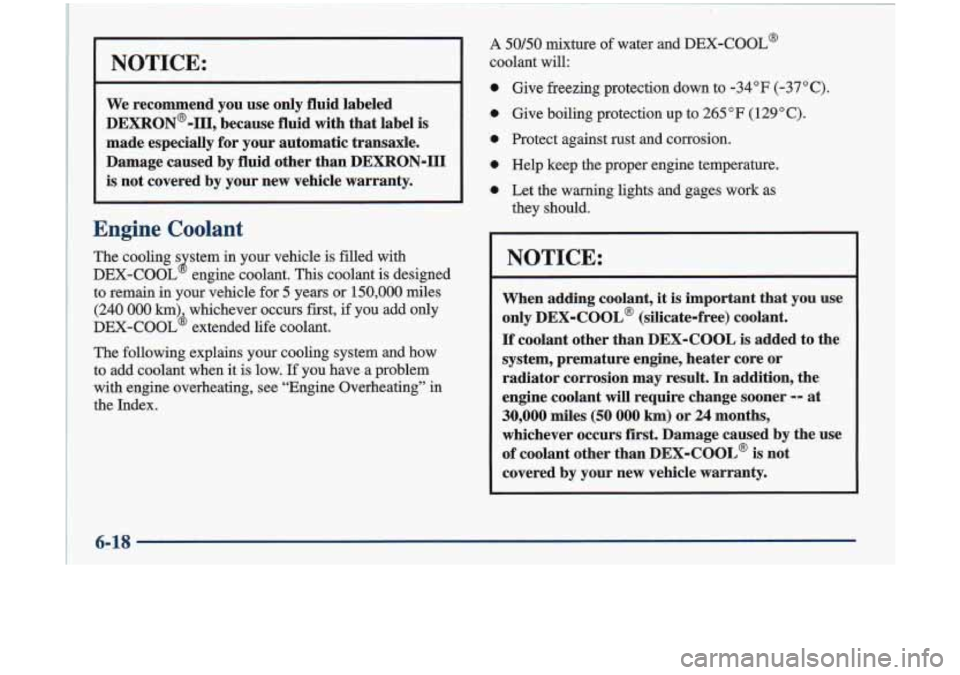
1 I
NOTICE:
We recommend you use only fluid labeled
DEXRON@-III, because fluid with that label is
made especially for your automatic transaxle.
Damage caused by fluid other than DEXRON-I11
is not covered by your new vehicle warranty.
Engine Coolant
The cooling s stem in your vehicle is filled with
DEX-COOL engine coolant. This coolant is designed
to remain in your vehicle for
5 years or 150,000 miles
(240 000 km) whichever occurs first, if you add only
DEX-COOL’ extended life coolant.
J
The following explains your cooling system and how
to add coolant when it is low. If you have a problem
with engine overheating,
see “Engine Overheating” in
the Index.
A 50/50 mixture of water and DEX-COOL@
coolant will:
0 Give freezing protection down to -34°F (-37°C).
0 Give boiling protection up to 265 OF (1 29 O C).
0 Protect against rust and corrosion.
0 Help keep the proper engine temperature.
0 Let the warning lights and gages work as
they should.
NOTICE:
When adding coolant, it is important that you use
only
DEX-COOL@ (silicate-free) coolant.
If coolant other than DEX-COOL is added to the
system, premature engine, heater core or
radiator corrosion may result. In addition, the
engine coolant will require change sooner
-- at
30,000 miles (50 000 km) or 24 months,
whichever occurs first. Damage caused by the use
of coolant other than DEX-COOL@
is not
covered by your new vehicle warranty.
6-18
Page 239 of 348
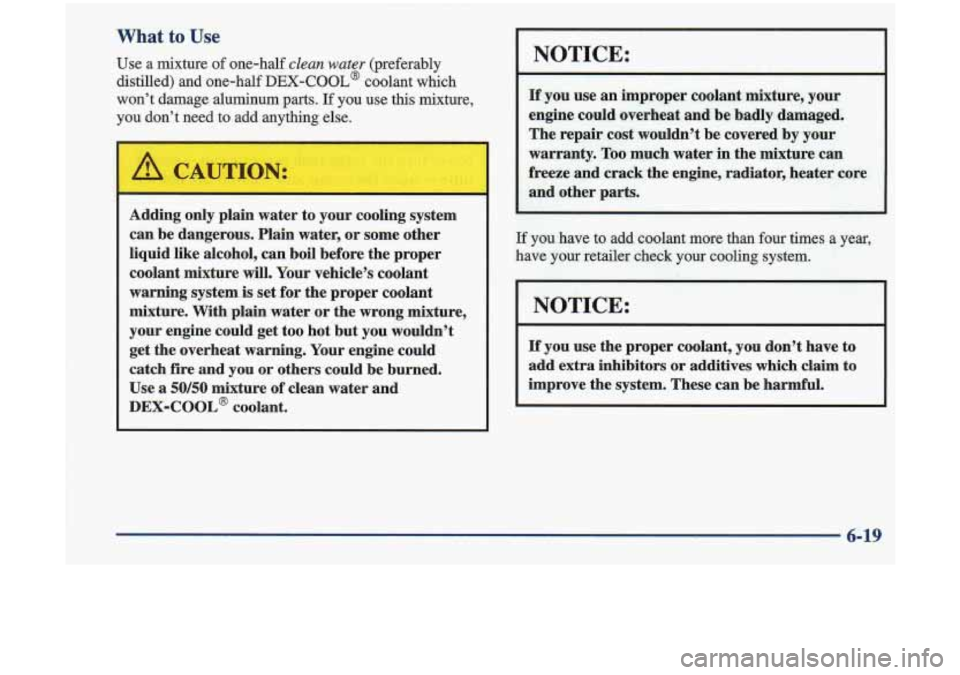
What to Use
Use a mixture of one-half clean water (preferably
distilled) and one-half
DEX-COOL@ coolant which
won’t damage aluminum
parts. If you use this mixture,
you don’t need to add anfthing else.
Adding only plain water to your coorrng system
can be dangerous. Plain water, or some other
liquid like alcohol, can boil before the proper
coolant mixture
will. Your vehicle’s coolant
warning system is set for the proper coolant
mixture. With plain water or the wrong mixture,
your engine could get too hot but you wouldn’t
get the overheat warning. Your engine could
catch fire and
you or others could be burned.
Use
a 50/50 mixture of clean water and
DEX-COOL@ coolant.
NOTICE:
If you use an improper coolant mixture, your
engine could overheat and be badly damaged.
The repair cost wouldn’t be covered by your
warranty. Too much water
in the mixture can
freeze and crack the engine, radiator, heater core
and other parts.
If you have to add coolant more than four times a year,
have your retailer check your cooling system.
I NOTICE:
If you use the proper coolant, you don’t have to
add extra inhibitors or additives which claim to
improve the system. These can be harmful.
6-19
Page 241 of 348
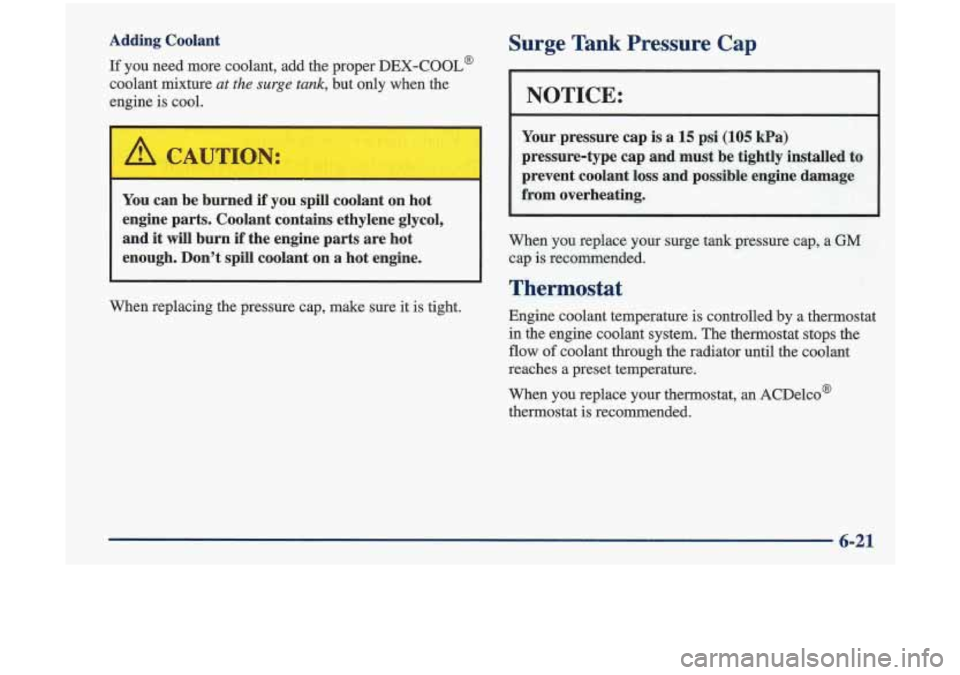
Adding Coolant
If you need more coolant, add the proper DEX-COOL@
coolant mixture at the surge tank, but only when the
engine
is cool.
Surge Tank Pressure Cap
NOTICE:
Your pressure cap is a 15 psi (105 kPa)
pressure-type cap and must be tightly installed to
prevent coolant
loss and possible engine damage
from overheating.
When you replace your surge tank pressure cap, a GM
cap is recommended.
Thermostat
Engine coolant temperature is controlled by a thermostat
in the engine coolant system. The thermostat
stops the
flow of coolant through the radiator until the coolant
reaches a preset temperature.
When you replace your thermostat, an ACDelco'
thermostat is recommended.
You can be burned if you spill coolant on hot
engine parts. Coolant contains ethylene glycol,
and it will burn if the engine parts are hot
enough. Don't spill coolant on a hot engine.
When replacing the pressure cap, make sure it is tight.
6-21
I/ I/
Page 337 of 348
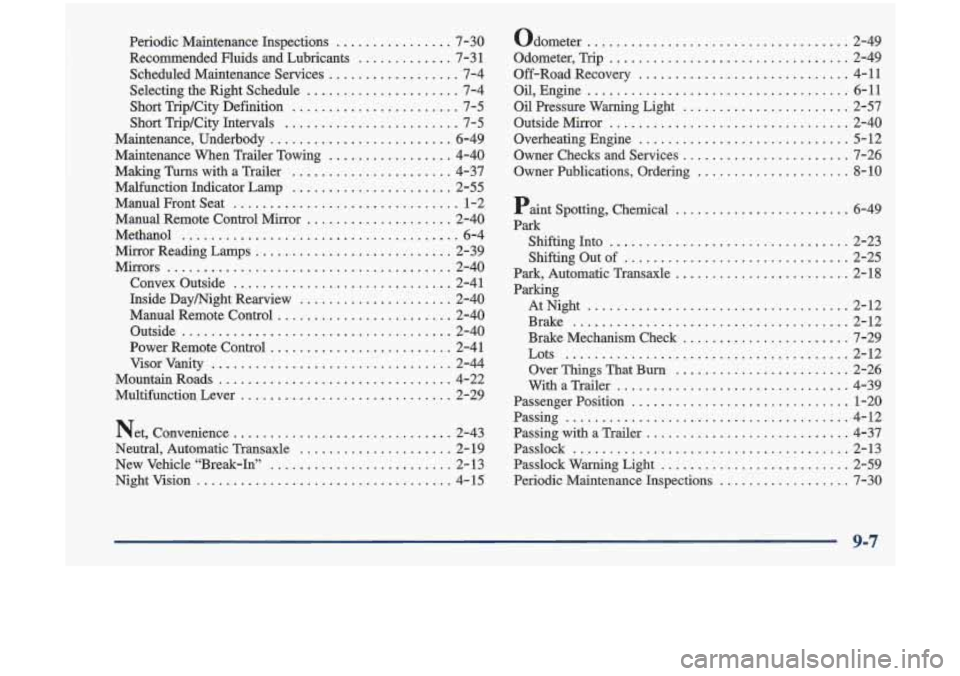
Periodic Maintenance Inspections ................ 7-30
Recommended Fluids and Lubricants
............. 7-3 1
Scheduled Maintenance Services .................. 7-4
Short Trip/City Definition
....................... 7-5
Short Trip/City Intervals
........................ 7-5
Maintenance. Underbody ......................... 6-49
Maintenance When Trailer Towing
................. 4-40
Making
Turns with a Trailer ...................... 4-37
Malfunction Indicator Lamp
...................... 2-55
Manual Front Seat
............................... 1-2
Manual Remote Control Mirror
.................... 2-40
Methanol
...................................... 6-4
Mirror Reading Lamps
........................... 2-39
Mirrors
....................................... 2-40
Convex Outside
.............................. 2-41
Inside Day/Night Rearview
..................... 2-40
Manual Remote Control
........................ 2-40
Outside
..................................... 2-40
Power Remote Control
......................... 2-41
Visor Vanity
................................. 2-44
MountainRoads
................................ 4-22
Multifunction Lever
............................. 2-29
Net. Convenience
.............................. 2-43
Neutral. Automatic Transaxle
..................... 2- 19
New Vehicle “Break-In”
......................... 2-13
Nightvision
................................... 4-15
Selecting the Right Schedule
..................... 7-4
Odometer
.................................... 2-49
Odometer. Trip
................................. 2-49
Off-RoadRecovery
............................. 4-11
Oil. Engine
.................................... 6-11
Oil Pressure Warning Light ....................... 2-57
Outside Mirror
................................. 2-40
Overheating Engine
............................. 5-12
Owner Checks and Services
....................... 7-26
Owner Publications. Ordering
..................... 8-10
Paint Spotting. Chemical ........................ 6-49
Park ShiftingInto
................................. 2-23
Shifting Out of
............................... 2-25
Park. Automatic Transaxle
........................ 2-18
Paxking
AtNight
.................................... 2-12
Brake
...................................... 2-12
Brake Mechanism Check
....................... 7-29
Lots
....................................... 2-12
Over Things That
Bum ........................ 2-26
WithaTrailer
................................ 4-39
Passenger Position
.............................. 1-20
Passing
....................................... 4-12
Passing with a Trailer
............................ 4-37
Passlock
...................................... 2-13
Passlock Warning Light
.......................... 2-59
Periodic Maintenance Inspections
.................. 7-30